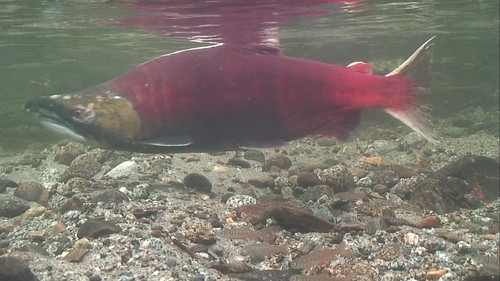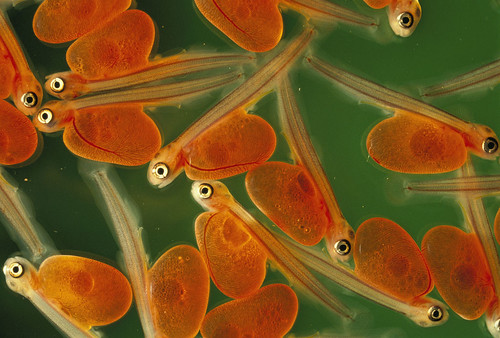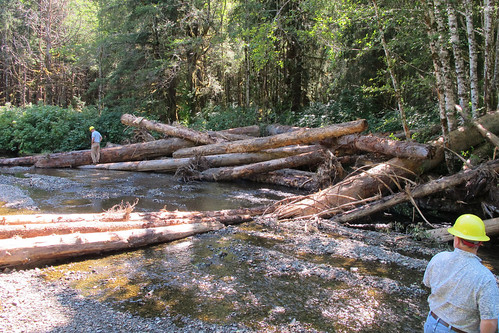
NOTE: Due to technical difficulties, we moved the salmon cam to the following URL: https://www.youtube.com/watch?v=4OuM4U3Z1jU
Gordie Reeves looks at salmon the way a man would look at pictures of his family. For Reeves, the salmon species is pretty much the best fish species around.
“They are dandelions of the fish world,” said Reeves, a research fish ecologist with the U.S. Forest Service. “They have this mechanism or strategy for persisting. We are under the illusion that everything in a stream should be perfect all the time, but that’s not true. It’s not the way the world works. Salmon do a terrific job under really incredible odds.”
Nature lovers can get a glimpse of salmon runs through a live streaming video. For the second year, the Forest Service is streaming from the bed of Juneau’s Steep Creek on the Tongass National Forest in Alaska.
Last year, the Steep Creek fish cam, near the Mendenhall Glacier in Juneau, Alaska, was viewed more than 28,000 times. Viewers watched sockeye and coho salmon – and sometimes just flowing water – for more than 627,000 minutes – or more than 10,000 viewing hours. They posted guesses on the types of fish moving in front of the camera and posted questions, which were answered by Pete Schneider, a fisheries biologist on the Tongass. A viewer even captured on video a portion of the live streaming video just as a bear went into the water, snatched a salmon and walked away to have dinner.
The best viewing times for the Alaska cam are between 8:30 a.m. and 1:30 a.m. Eastern Time. The camera operates around the clock, but there’s insufficient light for decent viewing outside these hours. Salmon up to 2 feet long are likely to pass by the cam around mid-July. Viewers also will see the smaller cutthroat trout and Dolly Varden (similar to bull trout).
What the cams can allude to but not capture is the lifespan of salmon. For every 100 eggs in a redd, or spawning nest, only two will make it back to its origins, Reeves said. Still, those are pretty good odds considering what some salmon species will encounter.
“They have this really incredible life history where they reverse the functions of their kidneys twice during their lifetime,” he said. “First, they start in fresh water, and then they are in saltwater and back again. They retain salt, and then they exude salt. That’s a crazy way to live, but they’ve done it. So from that perspective, it’s absolutely remarkable that they are back in terms of their survival.”

Their quest for survival starts even before the eggs are placed in the redd, or depressions in the river bed made by the adults using their tail fins. Deeper depressions are better so the current does not wash away the eggs before they can hatch in roughly three to four months. Once hatched the eggs, now called alevin, remain in the substrate surviving for weeks only on nutrients culled from the egg sac. Unless, of course, something eats them first.
The next stage begins when the nutrients from the sac deplete and the alevin enters the fry stage, grouping together in schools to feed on organisms in the stream, hide from other fish and struggle against the currents until they are large enough to enter the smolt stage. At this stage, the bodily functions of some salmon species change to make it possible for them to survive in salt water. Those salmon, such as the sockeye, are now young adults and begin the trip downstream to the ocean.
Salmon, again depending on the species, return to spawn in as little as a few months or as long as seven or more years. If they have survived to this point, the females’ eggs are fertilized, sometimes by many males, before she selects and prepares a site for spawning.
The growth they experienced is very important for the journey. They have to be strong to make the trip, and the bigger they get the more fat they have to help them navigate upstream, which often means jumping over natural and small man-made dams, fallen trees and other obstacles, including those that want them for dinner. The fat-infused salmon are attractive to bears, otters, coyotes and other prey animals that enjoy the nutrients the fish offer, especially the abundance of eggs. They also must get past human anglers to survive.
Finally, through all that growing, avoiding and surviving, the salmon arrive to a streambed deep enough to handle hundreds of salmon as they end their life cycle in order to give life to others. Even after the adult salmon are dead in those upstream waters, their carcasses continue to work by feeding an abundance of nutrients to the soil, plants, other fish and animals.
Follow the salmon cam on YouTube, on Twitter with @ForestService and on Facebook.

